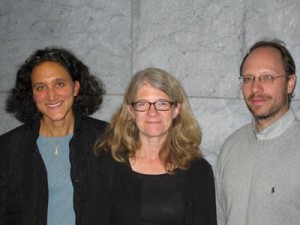Andrew Esguerra
Staff Writer

Photo: Barlow Der Mugrdechian
Shining a light on the efforts to preserve fragile links to cultures from long ago, Kristen St. John, a collections conservator at UCLA, concluded the Armenian Studies lecture series for the fall semester.
Speaking to an audience at Fresno State on November 28th, St. John brought her vast knowledge of the preservation and restoration of manuscripts to the lecture. Her expertise spans from Ethiopic to Byzantine scrolls—written and used anywhere from between the 11th to 19th centuries—to one particular Armenian artifact that has been the focus of her personal and professional interest for the past several years.
In the process of conserving historical manuscripts, utilizing the lightest and sometimes unorthodox materials, such as wheat paste to bind tears and repair damage is key. Rather than restoring the scrolls to a pristine state, explains St. John, the goal is to preserve them with the signs of use by the owners at the time. Problems that face the almost 7,000 manuscripts in the UCLA collection include tearing over time from being rolled up, and damage caused when previous owners tried doing repairs themselves. When approached by a colleague several years ago to help restore a scroll found in the Exhibits Collection of Near Eastern Materials Minasian Collection, St. John found an intriguing artifact of Armenian history, damaged from heavy use and discolored in some places.
Dating back to 1608, the Sargis scroll was written by a 17th century monk of the same name, according to the scroll’s colophon, the inscription at the end manuscript that usually details the date, author, topic, and owner of the work. Heavy use of the scroll points to its importance and the subject matter make the Sargis scroll a hmayil, or Armenian prayer scroll. It’s common for a hmayil to be damaged from regular use by the owners and examples of hmayil are found in the Madenataran and in other cultures, too.
Many questions are still raised about the hmayil and its purpose, contents, and origins, which motivated St. John to undo the deterioration of time, so that translators can work to answer some of the questions the artifact raises. The UCLA archives have also reached out to people for assistance in finding answers by uploading videos of the artifact onto Youtube. Discoveries about who made and owned these scrolls, their function and perception in Armenian and neighboring societies at the time, and the significance of the each of the scrolls’ contents will, in St. John’s view, benefit “anthropologists, historians, theologians, art historians” and more, “these scrolls could provide valuable information about how people lived and how their beliefs shaped their lives.”
Bringing her account of the personal interest she gained as she worked on the texts to an interested audience at Fresno State, promotes access and encourages other to also study the collection.
 Hye Sharzhoom Armenian Action
Hye Sharzhoom Armenian Action